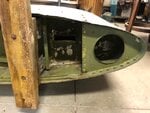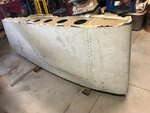68Mustangcrazy
Recruit
- 4
- Jan 18, 2021
I acquired this section of wing a while back from a remote property in southern AZ. The woman I got it from stated that it was on the property well before she moved there in the 70's and I'm estimating it was there since possibly the 50's. This wing was crated when left there and the crate deteriorated around it, (the pack rats carried a lot of it inside the wing cavities.) Anyway, I was looking at it for a project and planning to make a desk out of it. Before I do anything, I want to try and identify the type of aircraf it is from. Pics are attached and if anyone recognizes what plane this belongs to, I would appreciate some insight. Leading edge to trailing is 7'6" and 8' cross wing measurement is 33" and it is 11" thick at the largest point. From my "amateur" assessment, it appears to be a wing tip/end section.





